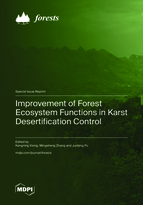Improvement of Forest Ecosystem Functions in Karst Desertification Control
A special issue of Forests (ISSN 1999-4907). This special issue belongs to the section "Forest Ecology and Management".
Deadline for manuscript submissions: closed (20 July 2023) | Viewed by 22987
Special Issue Editors
Interests: karst geomorphology and speleology; ecosystem function and service; natural world heritage conservation and desertification control
Special Issues, Collections and Topics in MDPI journals
Interests: karst plant physiology and molecules
Special Issues, Collections and Topics in MDPI journals
Interests: karst hydrological process; carbon cycle
Special Issues, Collections and Topics in MDPI journals
Special Issue Information
Dear Colleagues,
In the past 20 years, karst desertification control has achieved remarkable results, and South China Karst has been a global hotspot of greening. These improvements are closely related to large-scale afforestation and protection projects (the Grain for Green Project, Shelterbelt Development Project, Soil and Water Conservation Project, Natural Forest Conservation Project, Karst Desertification Treatment Project, etc.). On the one hand, ecological forests and agroforestry have been developed on a large scale in karst desertification control, which has improved the ecosystem’s function and the supply capacity of ecosystem services. However, there is a lack of systematic research on the vulnerability and resilience, structure and stability, ecological asset and service, carrying capacity and ecological security, and service tradeoff/synergy and optimization in the controlled ecosystem. On the other hand, there is a lack of research on the ecological processes of newly established forests in improving ecosystem functions and services, for example, how the functional traits (morphology and physiology) of newly established forests contribute to the maintenance of ecosystem functions and services compared with primary forests. Therefore, this Special Issue will publish articles that provide new perspectives and discoveries on the above issues.
Potential topics include, but are not limited to:
- Improvement mechanism of ecosystem structure, function, and service.
- The mechanism of ecosystem service tradeoff/synergy and function optimization.
- Optimization model of ecosystem function and improvement path of eco-product supply.
- The role of functional traits in the maintenance of ecological function and service.
- Social–ecological response for afforestation in the karst desertification control.
Prof. Dr. Kangning Xiong
Prof. Dr. Mingsheng Zhang
Prof. Dr. Junbing Pu
Guest Editors
Manuscript Submission Information
Manuscripts should be submitted online at www.mdpi.com by registering and logging in to this website. Once you are registered, click here to go to the submission form. Manuscripts can be submitted until the deadline. All submissions that pass pre-check are peer-reviewed. Accepted papers will be published continuously in the journal (as soon as accepted) and will be listed together on the special issue website. Research articles, review articles as well as short communications are invited. For planned papers, a title and short abstract (about 100 words) can be sent to the Editorial Office for announcement on this website.
Submitted manuscripts should not have been published previously, nor be under consideration for publication elsewhere (except conference proceedings papers). All manuscripts are thoroughly refereed through a single-blind peer-review process. A guide for authors and other relevant information for submission of manuscripts is available on the Instructions for Authors page. Forests is an international peer-reviewed open access monthly journal published by MDPI.
Please visit the Instructions for Authors page before submitting a manuscript. The Article Processing Charge (APC) for publication in this open access journal is 2600 CHF (Swiss Francs). Submitted papers should be well formatted and use good English. Authors may use MDPI's English editing service prior to publication or during author revisions.
Keywords
- ecosystem vulnerability
- ecosystem structure
- ecosystem function
- ecosystem service
- ecosystem service tradeoff
- functional trait
- carbon sequestration
- karst desertification






